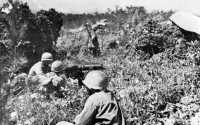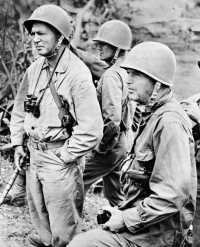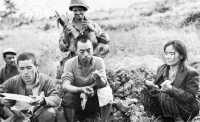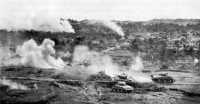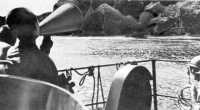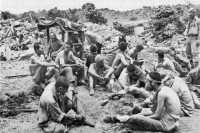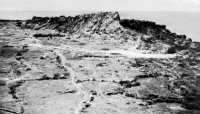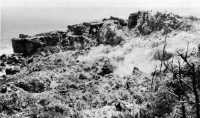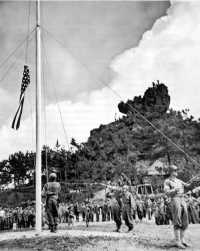Chapter 18: The Battle Ends
“We have passed the speculative phase of the campaign and are down to the final kill.” This was General Buckner’s appraisal of the battle for Okinawa on 15 June.1 Infantrymen on the front lines also sensed the impending disintegration of General Ushijima’s 32nd Army, not because of any noticeable weakening in the individual’s will to fight but because, destitute of the supplies and tools of war, of the coordination, communications, and skill necessary to a fighting machine, the Japanese collectively lacked the power of adequate resistance.
End of Organized Resistance
Most of General Ushijima’s crack troops were rotting in the rubble of the Shuri battlefield. Of the combat and service troops who had escaped to the south, a thousand were being killed each day.2 Those who lived had become a mass of uncoordinated troops fighting to the death but presenting no integrated defense against the Tenth Army attack ranging south toward the last prominent hills left to the Japanese.
Fight Before the Caves
After gaining the top of Hill 95 and the rim of the Yaeju-Dake, only a generally level plateau separated the XXIV Corps front lines from the cave headquarters of General Ushijima’s army which, according to prisoners of war, was located in a great coral ledge at the southern extremity of the Corps sector. This entire tableland, although evenly contoured, was liberally covered with coral heads. Some were grouped densely and formed a partial barrier; others were little larger than stumps or bushes and appeared to have grown from the earth. A few coral bulges were large and prominent enough to afford the Japanese strong positions. The largest of these were the Big Apple and Yuza-Dake Peaks
at the north end of the 96th Division’s sector. Within the zone of the 7th Division were Hills 153 and 115, jagged protuberances of coral which, after the fall of the Yaeju-Dake and Hill 95, became General Ushijima’s last hope of defending the eastern end of his line.
The 5-day battle for these hills and the fields of coral outcroppings on the surrounding plateau, lasting from 13 to 17 June, was as much like hunting as fighting. It was a battle of massed tanks which operated ahead of the usual infantry support, blasting the coral rocks with shell bursts and almost constant machine-gun fire. The battlefield was perfect for armored flame throwers, which poured flame into the caves and clusters of rocky crags and wooded areas, either killing the Japanese at once or forcing them into lanes of machine-gun fire. In five days flame tanks of the 713th Armored Flame Thrower Battalion directed more than 37,000 gallons of burning gasoline at the enemy.3 It was also a battle of infantry platoons or individual infantrymen against disorganized but desperate enemy soldiers.
Some of the largest cave defenses in southern Okinawa were in the Yaeju and Yuza Peaks. Infantrymen of the 96th Division destroyed these positions with hand and rifle grenades, satchel charges, and portable flame throwers. For the infantrymen it was a search for the enemy’s hiding places, often followed by a few minutes of reckless combat. Troops of the 381st Infantry occupied the commanding ground on the Big Apple Peak on 14 June but, for lack of enough explosives to seal the numerous caves in the area, were forced into a night-long fight with Japanese who emerged from the caves after darkness.4 Yuza Peak fell two days later, on 16 June. On the same day the 17th and 32nd Regiments reached Hill 153 and Hill 115, but another day of bitter fighting was required before the Japanese forces were completely destroyed.
Collapse of the 32nd Army
By the evening of 17 June, Tenth Army troops held a solid front line along the crests of Kunishi Ridge, Hill 153, and Hill 115, and, for the first time, could look south over the entire enemy-held territory, covering about eight square miles. Forced from its last defensive terrain and obliged to realize that nothing could prevent its destruction, General Ushijima’s army suddenly collapsed. Its discipline and morale, weakened by nearly eighty days of defeat, now broke completely and the 32nd Army degenerated into a mob.
Fighting toward Hill 89, tanks of the 769th Tank Battalion attack a bypassed Japanese strong point
On top of Yaeju-Dake 18 June, 96th Division infantrymen (below) probe hidden enemy pockets. Yellow cloth (right) marks the front lines for American bombers and fighters
As a unit, the 44th Brigade was destroyed when its command post on Hill 115 fell to the 32nd Infantry; only a few stragglers escaped. Enemy soldiers who had served in the 62nd Division fell back to defend the army headquarters at Hill 89. Approximately 400 members of the 24th Division – all that remained of the Japanese 32nd Regiment – were scattered through the caves near Kunishi Ridge, where they remained in hiding as the battle passed on to the south. The rest of the 24th Division retreated to its headquarters near Medeera, less than half a mile southwest of Hill 153.5
“Hill 153,” said General Ushijima in an order written a few hours after that hill fell to the 27th Infantry, “is the essential point at which the final destiny of the entire army must be decided. It is very painful to the Commanding General of the Army that the orders sent out from time to time... concerning that hill have been disregarded.” He ordered one battalion to recapture the hill before morning. A copy of this order was found the following morning on the body of one of the from 100 to 200 soldiers who tried to recapture Hill 153. On the back were notes written by the commander of the battalion:
The contents of the first paragraph of this Army Order were utterly unexpected by this battalion; it is, indeed extremely unfortunate.
The units which are to retake Hill 153 will carry out the Battalion orders without thought of losses, thereby bringing fame to the battalion.
When the hill is retaken, report its seizure immediately.6
An hour after daylight, 18 June, the Japanese soldiers who were to report the capture of Hill 153 lay dead and scattered through the coral pinnacles. Their attack had not even alarmed infantrymen of the 184th Infantry, which had replaced the 17th on the previous evening. The Japanese massed on the south side of the hill and milled about until they were killed.
On 18 June, in the last written official order of the 32nd Army, General Ushijima appointed an officer to lead the “Blood and Iron Youth Organization” and conduct guerilla warfare after the cessation of organized combat. At the same time he ordered remaining troops to make their way to the mountains in the northern end of Okinawa where a small band of guerillas was supposedly
already operating. The migration was to extend over several days; soldiers were to travel in groups of from two to five and were urged to wear civilian clothes and avoid conflict if possible.
This infiltration of Japanese was detected during the night of 18-19 June and both the front lines and rear installations burst into activity. Illumination flares hung over the southern tip of Okinawa between darkness and dawn, and the sound of machine-gun fire was almost constant through the night. This nighttime movement reached a peak several nights later, when one division, the 7th, killed 502 enemy soldiers. The infiltrating Japanese were not aggressive and carried weapons only for their own protection, their chief concern being to escape to the north or, in some instances, to submerge their identity in the civilian population.7
While some Japanese chose to chance the hazards of moving north, a great many fought savagely and were determined to take as many Americans as possible to death with them. The two divisions on the flanks found spotty and unpredictable resistance. On 18 and 19 June, the 6th Marine Division leapfrogged attacking battalions forward and plunged across the southwestern tip of the island. This fast-moving assault, and the advance of the 7th Division on the east, were opposed by machine guns and mortars but there was no integrated scheme of defense; the mass of civilians encountered delayed the troops almost as much as did enemy resistance. In the center, however, the 1st Marine and the 96th Infantry Divisions and the 305th Infantry, 77th Division, were opposed by the cornered remnants of the 24th Division, which made its last desperate stand near its command post at Medeera. The 5th Marines attacked Hill 81 in this area on four successive days before it fell on 21 June, and Hill 85 in the XXIV Corps sector was defended with the same die-hard determination.8 (See Map 54.)
In spite of the active role which tanks played in the fighting, a role which served to accelerate the battle, infantry combat went on as usual. One of the more conspicuous displays of recklessness occurred on 19 June when Company E, 305th Infantry, attacked several machine-gun nests. T/Sgt. John Meagher mounted a tank and was pointing out targets to the tank gunners when a Japanese raced toward the tank with a satchel charge. Meagher jumped from the tank, bayoneted the enemy soldier, and returned to the tank for a machine
Lt. Gen. Simon B. Buckner, Commanding General, Tenth Army (foreground), holding camera, photographed while observing action on the Marine front during the latter part of the campaign. With him, holding walking stick, is Maj. Gen. Lemuel C. Shepperd, Jr., Commanding General, 6th Marine Division
gun. Firing from his hip, he then moved through enemy fire toward the nearest pillbox, killed six enemy gunners there, and proceeded toward another machine gun. His ammunition gave out just as he reached the second pillbox. Meagher grabbed his empty gun by the barrel and beat the enemy crew to death. For this daring, one-man assault, Meagher was awarded the Congressional Medal of Honor.
Except for the Medeera pocket, front lines had almost disappeared by the evening of 21 June. Enemy troops, numbering between 15,000 and 18,000, were hiding in crevices in the great cliffs that walled the southern coast, in caves and ruined buildings, or in the brush, ditches, or coral. Some were waiting for an opportunity to surrender or were simply trying to evade American troops and prolong their own existence. Others, surrounded near Medeera, were fighting desperately with mortars and machine guns. Many of the Okinawa conscripts hoped to rejoin their families.
Although the ratio of Japanese killed to American casualties increased favorably, the latter remained relatively high as infantrymen combed the tip of the island for snipers or fought through the streets of Medeera and Makabe. Disorganization of the enemy force did not lessen the need for aggressive action, although the same effort by the troops usually resulted in a greater number of enemy casualties than in the Shuri area. From the fall of Shuri until front lines disappeared, Tenth Army lost 1,555 men killed in action and 6,602 wounded.9
Among those killed was General Buckner. Early in the afternoon of 18 June, General Buckner stopped at a forward observation post of the 8th Marine Regiment, 2nd Marine Division, near the southwest tip of Okinawa. Although this division staged a feint on 1 April and 19 April, none of its elements came ashore till June, when the 8th, after taking Theia and Iguni Islands, joined in the final battle.10 While General Buckner watched the progress of the fighting, at 1315, a shell from a Japanese dual purpose gun exploded directly above the observation post. A fragment of coral, broken off by the explosion, struck General Buckner in the chest. He collapsed immediately and died ten minutes later. Maj. Gen. Roy S. Geiger, senior commander on Okinawa, assumed command of Tenth Army.11 He was succeeded on 23 June by Gen. Joseph W. Stilwell.
Brig. Gen. Claudius M. Easley, assistant commander of the 96th Division, was killed the day after General Buckner’s death. General Easley, known by all as
a front-line soldier, was pointing out the location of a machine gun when two bullets from the gun struck him in the forehead. The lives of these two generals were added to more than 7,000 others of the Tenth Army as part of the cost of victory on Okinawa.12
Surrender and Suicide
Deterioration of Enemy Discipline and Morale
Until American troops occupied the last of its defensive terrain, the Japanese Army, in spite of adversities and broken fortunes, had maintained discipline and organization astonishingly well. When the process of dissolution began, however, it spread like an epidemic. Most Japanese soldiers lost hope of eventual victory when they abandoned Shuri. As early as 12 June the sound of their artillery had faded from its April rumble to a faint whisper, and small weapons were scarcer than men. “If hand grenades, explosives, etc., are dropped on the battlefield,” a Japanese general ordered, “every single item will be picked up; the man doing the salvaging will arm himself with them.”13
There was dissension among troops and officers. One prisoner said it was common for men to join other units without knowing the names of the unit and of its officers. Others reported that medical supplies were so low that treatment was limited to bandaging, and many of the wounded were left to die or to commit suicide. About half the troops were fighting in a daze, and rape was common since the soldiers felt that they had only a short time to live.14 These conditions existed even before Kunishi Ridge and Hill 153 were in American hands. After they fell the Japanese soldiers realized that no action in which they participated could have even momentary success.
Faced with these wretched conditions, Japanese officers had maintained discipline by assuring their soldiers that there was no alternative to death since the Americans would kill them if captured. On the other hand, Japanese officers promised their troops a counter landing, an airborne invasion, and a general all-out attack toward the latter part of June. According to prisoners of war who told of this persistent rumor, the 9th Division was to come from Formosa, and 500 planes and the remains of the Imperial Fleet were to participate in the great attack. One provision of this grandiose plan, however, was that, if the Japanese
Army on Okinawa were destroyed by 20 June, the counter landings would be canceled and the remaining troops would launch an all-out attack.15 The reports incidentally made Tenth Army troops wary and watchful for a banzai charge which many believed would come at the end of the battle.16
American Psychological Warfare
Decline of enemy morale may have resulted in part from a campaign of psychological warfare which General Buckner started before the April landing and intensified as the assault against the Yaeju-Dake began. From 25 March until the end of organized fighting, planes dropped about 8,000,000 propaganda leaflets on the island. Until mid-June these leaflets were aimed at winning the confidence of the civilians and soldiers and at spreading defeatism. Through a letter addressed to General Ushijima and dropped behind enemy lines on the morning of 10 June, General Buckner hoped to initiate mass surrender by the Japanese:–
The forces under your command have fought bravely and well, and your infantry tactics have merited the respect of your opponents. ... Like myself, you are an infantry general long schooled and practiced in infantry warfare. ... I believe, therefore, that you understand as clearly as I, that the destruction of all Japanese resistance on the island is merely a matter of days. ...17
General Buckner then invited Ushijima to enter negotiations for surrender. No one seriously expected Ushijima to respond to this bid for surrender. Two days later planes scattered another 30,000 leaflets over enemy ground, this time emphasizing Ushijima’s refusal to negotiate for surrender and his selfish determination to commit his entire army to destruction, and calling upon his subordinate officers and men to quit of their own accord. Another appeal was made on 14 June.
Actually, it was later learned, General Ushijima did not receive the original message until 17 June, the delay resulting from the lack of communications and the general confusion existing among his troops. Both he and his chief of staff, General Cho, considered the message hilariously funny and said that it would not be consonant with their honor as Samurai to entertain such a proposal.18
Overcoming the last resistance on Okinawa was aided by propaganda leaflets, one of which (above) is being read by a prisoner awaiting transportation to the rear. Many civilians gave up at the same time. At numerous points, however, severe fighting continued. Below, tanks are shown reducing an enemy position. Center tank was knocked out but was protected from capture by others. Shell burst mark location of Japanese
During the last days of the battle hundreds of thousands of “surrender leaflets” fell among Japanese soldiers who, caught between the sea and American front lines, were beginning to doubt the promises of their own government and army and to ponder the truth of American promises of humane treatment to those who came into American lines. A more direct appeal for surrender was made by the 7th Division on 17 June when all of its units ceased firing for an hour while interpreters broadcast pleas of surrender over portable loudspeakers. Several enemy soldiers walked toward the lines, watched for a few minutes, and then disappeared. One American soldier was wounded, and the Japanese put three holes through one of the loudspeakers. The appeal was wholly ineffective. On the same day, although firing continued, interpreters of the 7th Division set up a loudspeaker at the cliff southeast of Nakaza and coaxed between 500 and 600 civilians from natural caves in the rocky sea cliff. From this group the interpreters culled more than seventy enemy soldiers who had previously deserted their army and hoped to pass as civilians.19
Surrender and Suicide at the Water’s Edge
Mass surrender of Japanese soldiers did not begin until the Tenth Army crowded them almost to the water’s edge. There was a noticeable increase, however, after the intensification of the psychological warfare program. During the first seventy days of battle, prisoners captured by Tenth Army averaged less than four a day. This average increased to more than fifty a day between 12 and 18 June; and on 19 June, as the 6th Marine and 7th Infantry Divisions rolled forward near the east and west coasts, 343 enemy soldiers voluntarily surrendered. On the afternoon of 20 June the 32nd Infantry seized the east end of Hill 89, a coral bulge next to the sea which housed General Ushijima’s staff and headquarters. On the same day 977 prisoners were taken – an unprecedented accomplishment in the Pacific war.20
Even among these destitute and disorganized soldiers, less than a third chose to surrender rather than die, although prisoners claimed that others wanted to surrender but could find no opportunity. Casualties among the Japanese averaged about a thousand a day during the first half of June, jumped to nearly 2,000 on 19 June, to 3,000 the next day, and reached more than 4,000 on 21 June.21 This tremendous rise in enemy deaths resulted from the sudden and complete unbalance of power between the opposing forces and from the
Surrender instructions to the enemy were broadcast by this “converted” Japanese from an LCI standing off the rocky cliff near Hill 89. Below is seen a group of prisoners who preferred capture to suicide. They are waiting to be questioned by American officers
resignation of many Japanese to death. When cornered or injured, many of them would hold grenades against their stomachs and blow themselves to pieces – a kind of poor man’s hara-kiri. During the last days of the battle many bodies were found with the abdomen and right hand blown away – the telltale evidence of self-destruction. Men in the 184th Infantry counted at least sixteen separate explosions when an armored flame thrower threatened a troublesome source of enemy fire. One Japanese soldier approached a field artillery outpost, jumped into plain view, and yelled in understandable English: “Watch out! I’m going to blow my head off!” He fulfilled his promise, but a companion with him had to be killed. Many others hid among the brush and rocks until the Americans were almost upon them. Then they would suddenly jump up, throw a grenade or fire a few aimless shots, and wait to be killed.22
Sometimes the conditions under which the Japanese met defeat were less tragic. A small landing craft idled along the southern coast one or two hundred yards from shore and, through a loudspeaker mounted on its deck, a “converted” prisoner of war shouted appeals for surrender to other Japanese soldiers who had retreated to the water’s edge and now lurked among the boulders at the foot of the cliff or in caves in its face. The prisoner, a sergeant in the Japanese Army, was a persuasive speaker who was convinced of good treatment in the hands of Americans and tried to save his comrades from needless death. Sometimes he would order the soldiers to leave their hiding places, strip to their loin cloths, and follow the coast north to the American lines; as a sergeant, he was often obeyed.23
Interpreters or prisoners broadcast pleas of “cease resistance” over other portable loudspeakers set up in the southern tip of the island. The Japanese surrendered by twos or threes, apprehensive and hesitant and with curious expressions of hope and fear. Many prisoners offered to return to induce their comrades to surrender. Usually they were given cigarettes to take back to the caves as proof of American promises. Two such “bait-boys,” known as “Murrymoto” and “Goto,” brought back several hundred prisoners and were so faithful that their captors allowed them to carry weapons and live in the company perimeter during the night. In this manner 7,401 Japanese soldiers, including more than 200 commissioned officers and 3,339 unarmed laborers, surrendered to Tenth Army troops.24
Okinawa Civilians
Civilians became a nuisance to combat units after the assault on the final enemy lines began, and remained a burden until front lines no longer existed. More than 10,000 civilians stayed on Chinen Peninsula and were relatively unharmed by the battle. A much larger number, forced south by the advancing lines, hid in caves or stone huts until they were overtaken. Then they tried to pass through the machine-gun and shell fire to enter American lines or attempted the even more hazardous feat of slipping through the front lines during darkness. Infantrymen helped these unfortunate civilians as much as possible and often interrupted the fighting to collect and guide them through the front lines. During the last days of the fighting there were always groups of civilians sitting just behind the front lines, waiting for help, instructions, or, as many of them believed, death.25
Eighty thousand Okinawa civilians, between a third and a half of whom were wounded, crawled from caves at the south tip of the island during the last two weeks of June. These were either children, the very old, or women; there were few able-bodied men among them. In long columns they walked toward the rear. Most of the women carried babies on their backs and bundles of clothing, food, dishes, and kettles on their heads – all they owned. They chewed stalks of sugar cane when they could find them. The bodies of many thousands of other civilians lay scattered in the ditches, in the cane fields, and in the rubble of the villages, or were sealed in caves.26
The Death of Generals Ushijima and Cho
As General Ushijima and his staff concluded the activities of the 32nd Army in the system of caves within Hill 89, near Mabuni, the 32nd Infantry attacked across the broad and flat top of the hill. One entrance to the cave was on top and near the center of the 500-yard-long hill; another entrance opened on the face of the 290-foot cliff facing the sea. It was about noon on 21 June when the front lines reached the first of these entrances. An officer prisoner had volunteered to deliver another offer of surrender to Ushijima but, when he and the infantrymen gathered near the opening, the Japanese closed the entrance by blasting it from the inside. Enemy resistance on top of Hill 89 was strong, and flame tanks used
The last Japanese command post on Okinawa was Hill 89. The 32nd Infantry, 7th Division, attacked up the lower east end (left)
The still smoldering reverse slope of Hill 89, where Generals Ushijima and Cho committed suicide
nearly 5,000 gallons of gasoline before the entire top was free of Japanese soldiers that evening.27
General Ushijima radioed his last message to Imperial Headquarters on the evening of 21 June. The impetuous General Cho made a last appeal for all units to fight to the utmost. He also prepared several messages which he hoped his secretary could eventually deliver in Japan. “Our strategy, tactics, and technics,” he explained, “all were used to the utmost and we fought valiantly, but it was as nothing before the material strength of the enemy.”28 Realizing that they could hold out no longer, Generals Ushijima and Cho made ready for death. Their cook prepared an especially large meal to be served shortly before midnight. When the meal was finished, the two generals and their staff drank numerous farewell toasts with the remaining bottles of Scotch whiskey which had been carried from Shuri. The rest of the story is told by a prisoner who learned the details of the death of Ushijima and Cho from other prisoners:
Alas! The Stars of the Generals have fallen with the setting of the waning moon over Mabuni. ...
The pale moon shimmers bluish white over the waters of the southern sea, but on Hill 89 which juts abruptly from the reefs, the rocks and boulders are dyed crimson by the blood of the penetration unit which, with burning patriotism, rush the American positions for the last stand. The surrounding area displays a picture of concentrated fireworks; bursts of naval gun fire, flashes of mortar and artillery fire, to which is added the occasional chatter of machine guns. ...
Gathered around their section chiefs, members of each section bow in veneration toward the eastern sky and the cheer of “long live the Emperor” echoes among the boulders. ... The faces of all are flushed with deep emotion and tears fall upon ragged uniforms, soiled with the dirt and grime of battle. ...
Four o’clock, the final hour of Hara-kiri; the Commanding General, dressed in full field uniform, and the Chief of Staff in a white kimono appeared. ... The Chief of Staff says as he leaves the cave first, “Well, Commanding General Ushijima, as the way may be dark, I, Cho, will lead the way.” The Commanding General replies, “Please do so, and I’ll take along my fan since it is getting warm.” Saying this he picked up his Okinawa-made Kuba fan and walked out quietly fanning himself. ...
The moon, which had been shining until now, sinks below the waves of the western sea. Dawn has not yet arrived and, at 0410, the generals appeared at the mouth of the cave. The American forces were only three meters away [sic]. Four meters away from the mouth of the cave a sheet of white cloth is placed on a quilt; this is the ritual place for the two Generals to commit Hara-kiri. The Commanding General and the Chief of Staff sit down
on the quilt, bow in reverence towards the eastern sky, and Adjutant J. respectfully presents the sword. Finally, the time for the honored rites of Hara-kiri arrives. At this time several grenades were hurled near this solemn scene by the enemy troops who observed movements taking place beneath them. A simultaneous shout and a flash of a sword, then another repeated shout and a flash, and both Generals had nobly accomplished their last duty to their Emperor. ...
All is quiet after the cessation of gunfire and smoke; and the full moon is once again gleaming over the waves of the southern sea. Hill 89 of Mabuni will live in memory forever.29
The death of General Ushijima and his Chief of Staff, General Cho, marked the end of the Okinawa campaign and the 32nd Army. Organized fighting on Okinawa had lasted eighty-three days, for it was not until 22 June that Hill 85 between Medeera and Makabe fell to the 305th Infantry. That the Japanese defense had been longer and stronger than could reasonably have been expected was not, it appeared, sufficient for the Japanese commander. Following the ancient code and ritual of the Samurai, he made the only acceptable atonement to his emperor for his failure to defend Okinawa successfully.
At Tenth Army headquarters on the same morning, 22 June, representatives of the Tenth Army, the two corps, and the divisions stood in formation, the band played “The Star Spangled Banner,” and the color guard raised the American flag over Okinawa. Near the top of the pole a sudden breeze swept the flag out full against a blue and quiet sky.30
Final Mop-up
On 23 June 1945 Tenth Army began a thorough and coordinated mop-up campaign to eliminate the disorganized remnants of the 32nd Army in southern Okinawa. The plan assigned XXIV Corps and III Amphibious Corps their respective zones of action and fixed three phase lines for the completion of the task, which was to take ten days. After reaching the first phase line at the southern end of the island, the two corps were to turn and advance northward through two successive phase lines until they reached the Naha–Yonabaru valley. A blocking line was established along the Naha–Yonabaru cross-island road to prevent any Japanese soldiers from infiltrating to the northern part of the island.31
Raising the American flag on 22 June denoted the end of organized resistance
The mop-up was successfully completed on 30 June, in less than the allotted time. The troops first cleaned out some strong pockets of unorganized resistance in the sweep to the first phase line in the south. Cave positions were systematically sealed up by flame throwers and demolitions, with hundreds of Japanese entombed within. Several bloody skirmishes ensued when well-armed groups of the enemy attempted to infiltrate the American lines and make their way to the north. Extensive patrolling ferreted out individual Japanese soldiers hiding in cane fields and rice paddies. Once the American troops turned northward, fewer and fewer of the enemy were found, and the third and final phase line was reached with comparative ease. By the end of the month the mop-up had yielded an estimated total of 8,975 Japanese soldiers killed, 2,902 military prisoners taken, and 906 labor troops rounded up. Large quantities of enemy supplies and equipment were captured.32 American battle casualties between 23 and 30 June came to 783, most of which were incurred in the first three days of the mop-up. On 2 July the Ryukyus campaign was declared ended.
Victory: Cost and Value
The price paid for Okinawa was dear. The final toll of American casualties was the highest experienced in any campaign against the Japanese. Total American battle casualties were 49,151, of which 12,520 were killed or missing and 36,631 wounded. Army losses were 4,582 killed, 93 missing, and 18,099 wounded; Marine losses, including those of the Tactical Air Force, were 2,938 killed and missing and 13,708 wounded; Navy casualties totaled 4,907 killed and missing and 4,824 wounded. Non-battle casualties during the campaign amounted to 15,613 for the Army and 10,598 for the Marines. The losses in ships were 36 sunk and 368 damaged, most of them as a result of air action. Losses in the air were 763 planes from 1 April to 1 July.
The high cost of the victory was due to the fact that the battle had been fought against a capably led Japanese army of greater strength than anticipated, over difficult terrain heavily and expertly fortified, and thousands of miles from home. The campaign had lasted considerably longer than was expected. But Americans had demonstrated again on Okinawa that they could, ultimately, wrest from the Japanese whatever ground they wanted.
The cost of the battle to the Japanese was even higher than to the Americans. Approximately 110,000 of the enemy lost their lives in the attempt to hold
Okinawa, and 7,400 more were taken prisoners. The enemy lost 7,800 airplanes, 16 ships sunk, and 4 ships damaged. More important, the Japanese lost 640 square miles of territory within 350 miles of Kyushu.
The military value of Okinawa exceeded all hope. It was sufficiently large to mount great numbers of troops; it provided numerous airfield sites close to the enemy’s homeland; and it furnished fleet anchorage helping the Navy to keep in action at Japan’s doors. As soon as the fighting ended, American forces on Okinawa set themselves to preparing for the battles on the main islands of Japan, their thoughts sober as they remembered the bitter bloodshed behind and also envisioned an even more desperate struggle to come.
The sequel to Okinawa, however, was contrary to all expectation. In the midst of feverish preparations on the island in August 1945, with the day for the assault on Kyushu drawing near, there came the almost unbelievable and joyous news that the war was over. The battle of Okinawa was the last of World War II.

